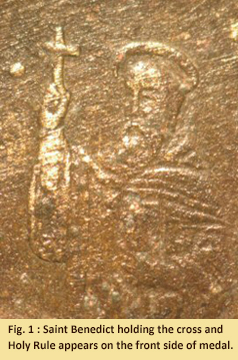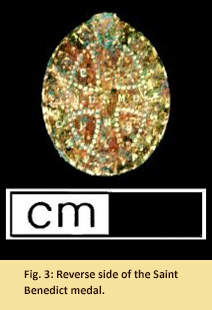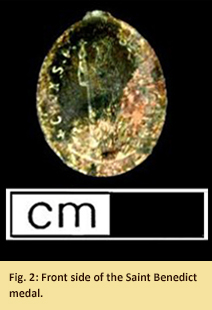Curator's Choice 2009
Saint Benedict Medal
February 2009
By Erin Wingfield, MAC Lab Collections Assistant
 This small but significant find was recovered from Johnsontown, an archaeological site located in Charles County. The Saint Benedict medal was recovered by a local architectural historian who collected artifacts on the property over several years. The property of 'Johnson Towne' was purchased in 1665 by Henry Hawkins. He owned multiple tracts of land and held several influential positions including sheriff, justice and member of the lower house of the assembly. Artifacts found at Johnsontown suggest the site was occupied until 1740 (King et al. 2008:17-18).
This small but significant find was recovered from Johnsontown, an archaeological site located in Charles County. The Saint Benedict medal was recovered by a local architectural historian who collected artifacts on the property over several years. The property of 'Johnson Towne' was purchased in 1665 by Henry Hawkins. He owned multiple tracts of land and held several influential positions including sheriff, justice and member of the lower house of the assembly. Artifacts found at Johnsontown suggest the site was occupied until 1740 (King et al. 2008:17-18).
This type of Saint Benedict medal is commonly referred to as an ordinary medal (Herbermann 1913:338). This particular medal is an oval shape approximately 1.6 cm by 1.2 cm. A medal this small would probably have been worn on a rosary instead of individually.
The front of the medal depicts Saint Benedict holding a cross in his right hand (Figure 1&2). In his otherhand he holds the Benedictine Rule, a guideline written by the Saint for monastic life and discipline (Sutera 1997:2). On either side of Benedict are a raven and a cup. Both symbols represent periods in Benedict's life when he was saved by his faith. The central image is surrounded by the inscription CRUX S.P. BENEDICTI, which stands for Crux Sancti Patris Benedicti, the "Cross of the Holy Father Benedict" (Gueranger 1880:11).
The reverse side (Figure 3) shows a cross surrounded by the initials V.R.S.N.S.M.V.S.M.Q.L.I.V.B. This represents the Latin initials for Vade Retro, Satana; Nunquam Suade Mihi Vana. Sunt Mala Quae Libas; Ipse Venena Bibas, which translates into "Begone, Satan! And suggest not to me your vain things. The cup you offer me is evil; drink your own poison." The horizontal bar ofthe cross isinscribed with N.D.S.M.D., representing Non Draco Sit Mihi Dux or "Let not the dragon be my guide." The vertical bar of the cross contains the initials C.S.S.M.L., for the phrase Crux SacraSit Mihi Lux, "May the holy cross be my light." The four corners of the cross contain the initials C.S.P.B., once again representing the phrase Crux Sancti Patris Benedicti (Gueranger 1880:12-13).

 The ordinary medal was designed after the discovery of a manuscript originally written in 1415. The manuscript contained a drawing of Saint Benedict holding a scroll in one hand and a cross in the other. Phrases written around the image were later represented as initials on the back of the medal. The first medals were created in Germany during the 17th century and spread with popularity throughout Europe (Herbermann 1913:338).
The ordinary medal was designed after the discovery of a manuscript originally written in 1415. The manuscript contained a drawing of Saint Benedict holding a scroll in one hand and a cross in the other. Phrases written around the image were later represented as initials on the back of the medal. The first medals were created in Germany during the 17th century and spread with popularity throughout Europe (Herbermann 1913:338).
Wearing the medal of Saint Benedict is considered to be a silent continuous prayer (Sutera 1997:109). The medal is worn to cure sickness, the affects of poisoning and also for general physical protection (Gueranger 1880:25-26). The Saint Benedict medal is also the only medal used for exorcism (Sutera 1997:109). The phrases on the reverse side of the medal are believed to have been spoken by Benedict to banish Satan and his temptations (Sutera 1997:109). Overall, the medal would have been used to cleanse the body and soul of evil influences or even the devil himself.
| References |
|
| Gueranger, Prosper |
| 1880 |
The Medal or Cross of St. Benedict. Burns and Oates, London. |
|
| Herbermann, Charles George. (editor) |
| 1913 |
The Catholic Encyclopedia. Encyclopedia Press, New York. |
|
| King, Julia, Scott M. Strickland, and Kevin Norris |
| 2008 |
The Search for the Court House at Moore's Lodge: Charles County's First County Seat. Report Prepared for the Citizens of Charles County. |
|
| Sutera, Judith |
| 1997 |
The Work of God: Benedictine Prayer. Liturgical Press, Minnesota. |
|